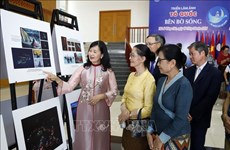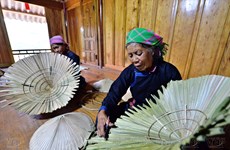Ninh Thuan festooned for Cham fest
The Brahminical Cham community
celebrates the Kate festival on the first day of the seventh lunar
month (October 18 this year) to revere its gods, heroes, ancestors, and
kings.
The Brahminical Cham community
celebrates the Kate festival on the first day of the seventh lunar
month (October 18 this year) to revere its gods, heroes, ancestors, and
kings.
The biggest Cham population in the country, in the central province of Ninh Thuan , celebrates the festival at three towers named after kings and queens – Po Rome and Po Inu Nugar in Ninh Phuoc District and Po Klong Giarai in Phan Rang city, which is also the most popular venue.
On the last 10 days of the sixth lunar month, the Cham make offerings to their ancestors to ask for their help in organising Kate and thank them beforehand.
In the first festival day, hundreds of people gathered early in the morning at the Y trang Ngai shrine (Costume of the Genie) in Phuoc Dong hamlet, Phuoc Hau District, for a ceremony to bring the King Po Klong Giarai’s costumes to the eponymous tower.
Among them were dozens of Raglai people in violet costumes (the Cham are in white).
At 5am, Kamunay , the old man who takes care of the shrine, offered liquor, eggs, fruits, betel, and areca to seek the deity’s permission to take the costumes to Po Klong Giarai Tower.
When he finished his task, seven Cham girls in ao dai Cham (the traditional long dress with a red belt) performed the traditional Patri dance accompanied by Gi Nang and Branung drums and Saranai trumpets. The Raglai danced with their cong and chieng (Gong).
A palanquin came in a procession to Po Klong Giarai Tower, which is around 4km away. The procession was packed with revellers and accompanied by the ubiquitous Raglai music. As it passed by, residents in Cham villages joined in.
Before the procession arrived at the tower, thousands of Cham in colourful traditional costumes flocked to the Po Klong Giarai Tower to celebrate Kate . Women wearing festive clothes balanced trays or baskets of gifts on their heads.
"Po Klong Giarai was the king who brought peace to his people. He reigned in the 12th-13th centuries and made great contributions to the development of agriculture," Dan Dieu, a priest, says.
According to legend, a Cham couple once saw a small bag drifting along a river and fished it out. Inside was a baby girl whom they took home to bring up.
When the child grew up into a young woman, one day she went to the forest with her parents to cut wood. Feeling thirsty, she drank water from a brook and became pregnant.
In due course, she delivered a baby boy named Po Ong. He was said to be the son of Po Sah Ino who had leprosy as a child and was cured by the Snake God before becoming deified.
People made Po Ong king but some refused to accept this saying he was a mere cowherd and betel seller. Po Ong relinquished the throne and became a monk. Soon, there was an invasion by the Khmer and people beseeched him to take over the throne again. Po Klong Giarai thus means "the king who returned."
"He built the Chaklin (Nha Trinh) reservoir and two channels (Male and Female) to irrigate the main fields in northern Phan Rang, which are in use to this day," Dien says.
Because of the tower’s association with the greatness of the king, the Kate festival was held here for people to express their respect for him. It lasted three days.
A ceremony to receive the costume began as soon as the procession arrived at the tower.
Afterwards, the Cham girls and the Raglai danced in front of the tower.
The oldest priest, Po Dhia, and Kamunay join other priests to offer wine, betel and areca, and bath water mixed with aloe and seek Lord Siva’s permission to open the tower.
Kamunay sang: "We bring water from the River Hang ( Ganges ) for you to take a bath. You are the creator of this universe. We would like to have the best towels to wipe the sweat on your body, hands, and legs."
He then took a jar of holy water to splash on the Siva idol in the arch above the tower door.
"This ritual is done at a certain time. When the priests finish the ritual offering, the sunlight reaches the tower door," Dut says.
Po Dhia, Kamunay, and Muk Pajau, a psychic, then bathed and dressed the idols while a Cham man, Kadhar, played the kanhi , a stringed instrument, and sang a song to extol the King’s greatness.
Devotees took the water used to bathe Po Klong Giarai and sprinkled it on their heads to invoke his blessing.
After King Po Klong Giarai was adorned with the ceremonial costume, the sacrifices were laid out on the altar for the great ceremony. Kadhar started singing the festive song, Muk Pajau offered a toast for Po Klong Giarai, Po Dhia splashed the holy water, and beneath them devotees clasped their hands together to pray.
At 2pm the tower door was closed and people went back to celebrate Kate at home. Authorities sent delegations to make courtesy calls on the priests and gave them gifts./.
The biggest Cham population in the country, in the central province of Ninh Thuan , celebrates the festival at three towers named after kings and queens – Po Rome and Po Inu Nugar in Ninh Phuoc District and Po Klong Giarai in Phan Rang city, which is also the most popular venue.
On the last 10 days of the sixth lunar month, the Cham make offerings to their ancestors to ask for their help in organising Kate and thank them beforehand.
In the first festival day, hundreds of people gathered early in the morning at the Y trang Ngai shrine (Costume of the Genie) in Phuoc Dong hamlet, Phuoc Hau District, for a ceremony to bring the King Po Klong Giarai’s costumes to the eponymous tower.
Among them were dozens of Raglai people in violet costumes (the Cham are in white).
At 5am, Kamunay , the old man who takes care of the shrine, offered liquor, eggs, fruits, betel, and areca to seek the deity’s permission to take the costumes to Po Klong Giarai Tower.
When he finished his task, seven Cham girls in ao dai Cham (the traditional long dress with a red belt) performed the traditional Patri dance accompanied by Gi Nang and Branung drums and Saranai trumpets. The Raglai danced with their cong and chieng (Gong).
A palanquin came in a procession to Po Klong Giarai Tower, which is around 4km away. The procession was packed with revellers and accompanied by the ubiquitous Raglai music. As it passed by, residents in Cham villages joined in.
Before the procession arrived at the tower, thousands of Cham in colourful traditional costumes flocked to the Po Klong Giarai Tower to celebrate Kate . Women wearing festive clothes balanced trays or baskets of gifts on their heads.
"Po Klong Giarai was the king who brought peace to his people. He reigned in the 12th-13th centuries and made great contributions to the development of agriculture," Dan Dieu, a priest, says.
According to legend, a Cham couple once saw a small bag drifting along a river and fished it out. Inside was a baby girl whom they took home to bring up.
When the child grew up into a young woman, one day she went to the forest with her parents to cut wood. Feeling thirsty, she drank water from a brook and became pregnant.
In due course, she delivered a baby boy named Po Ong. He was said to be the son of Po Sah Ino who had leprosy as a child and was cured by the Snake God before becoming deified.
People made Po Ong king but some refused to accept this saying he was a mere cowherd and betel seller. Po Ong relinquished the throne and became a monk. Soon, there was an invasion by the Khmer and people beseeched him to take over the throne again. Po Klong Giarai thus means "the king who returned."
"He built the Chaklin (Nha Trinh) reservoir and two channels (Male and Female) to irrigate the main fields in northern Phan Rang, which are in use to this day," Dien says.
Because of the tower’s association with the greatness of the king, the Kate festival was held here for people to express their respect for him. It lasted three days.
A ceremony to receive the costume began as soon as the procession arrived at the tower.
Afterwards, the Cham girls and the Raglai danced in front of the tower.
The oldest priest, Po Dhia, and Kamunay join other priests to offer wine, betel and areca, and bath water mixed with aloe and seek Lord Siva’s permission to open the tower.
Kamunay sang: "We bring water from the River Hang ( Ganges ) for you to take a bath. You are the creator of this universe. We would like to have the best towels to wipe the sweat on your body, hands, and legs."
He then took a jar of holy water to splash on the Siva idol in the arch above the tower door.
"This ritual is done at a certain time. When the priests finish the ritual offering, the sunlight reaches the tower door," Dut says.
Po Dhia, Kamunay, and Muk Pajau, a psychic, then bathed and dressed the idols while a Cham man, Kadhar, played the kanhi , a stringed instrument, and sang a song to extol the King’s greatness.
Devotees took the water used to bathe Po Klong Giarai and sprinkled it on their heads to invoke his blessing.
After King Po Klong Giarai was adorned with the ceremonial costume, the sacrifices were laid out on the altar for the great ceremony. Kadhar started singing the festive song, Muk Pajau offered a toast for Po Klong Giarai, Po Dhia splashed the holy water, and beneath them devotees clasped their hands together to pray.
At 2pm the tower door was closed and people went back to celebrate Kate at home. Authorities sent delegations to make courtesy calls on the priests and gave them gifts./.













